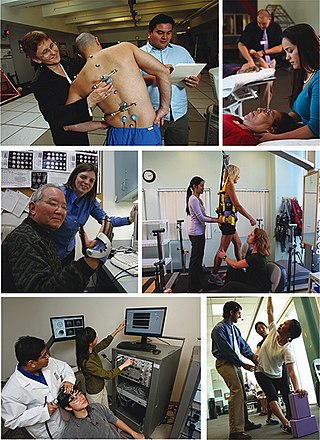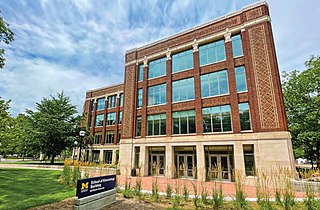Related Research Articles
Language education – the process and practice of teaching a second or foreign language – is primarily a branch of applied linguistics, but can be an interdisciplinary field. There are four main learning categories for language education: communicative competencies, proficiencies, cross-cultural experiences, and multiple literacies.

Physical education, often abbreviated to Phys. Ed. or PE, is a subject taught in schools around the world. PE is taught during primary and secondary education and encourages psychomotor, cognitive, and affective learning through physical activity and movement exploration to promote health and physical fitness. When taught correctly and in a positive manner, children and teens can receive a storm of health benefits. These include reduced metabolic disease risk, improved cardiorespiratory fitness, and better mental health. In addition, PE classes can produce positive effects on students' behavior and academic performance. Research has shown that there is a positive correlation between brain development and exercising. Researchers in 2007 found a profound gain in English Arts standardized test scores among students who had 56 hours of physical education in a year, compared to those who had 28 hours of physical education a year.

Pedagogy, from Ancient Greek παιδαγωγία (paidagōgía), most commonly understood as the approach to teaching, is the theory and practice of learning, and how this process influences, and is influenced by, the social, political, and psychological development of learners. Pedagogy, taken as an academic discipline, is the study of how knowledge and skills are imparted in an educational context, and it considers the interactions that take place during learning. Both the theory and practice of pedagogy vary greatly as they reflect different social, political, and cultural contexts.

Experiential learning (ExL) is the process of learning through experience, and is more narrowly defined as "learning through reflection on doing". Hands-on learning can be a form of experiential learning, but does not necessarily involve students reflecting on their product. Experiential learning is distinct from rote or didactic learning, in which the learner plays a comparatively passive role. It is related to, but not synonymous with, other forms of active learning such as action learning, adventure learning, free-choice learning, cooperative learning, service-learning, and situated learning.

Kinesiology is the scientific study of human body movement. Kinesiology addresses physiological, anatomical, biomechanical, pathological, neuropsychological principles and mechanisms of movement. Applications of kinesiology to human health include biomechanics and orthopedics; strength and conditioning; sport psychology; motor control; skill acquisition and motor learning; methods of rehabilitation, such as physical and occupational therapy; and sport and exercise physiology. Studies of human and animal motion include measures from motion tracking systems, electrophysiology of muscle and brain activity, various methods for monitoring physiological function, and other behavioral and cognitive research techniques.
A didactic method is a teaching method that follows a consistent scientific approach or educational style to present information to students. The didactic method of instruction is often contrasted with dialectics and the Socratic method; the term can also be used to refer to a specific didactic method, as for instance constructivist didactics.

Andragogy refers to methods and principles used in adult education. The word comes from the Greek ἀνδρ- (andr-), meaning "adult male", and ἀγωγός (agogos), meaning "leader of". Therefore, andragogy literally means "leading men ", whereas "pedagogy" literally means "leading children".

Sports science is a discipline that studies how the healthy human body works during exercise, and how sport and physical activity promote health and performance from cellular to whole body perspectives. The study of sports science traditionally incorporates areas of physiology, psychology, anatomy, biomechanics, biochemistry, and kinesiology.
This is an index of education articles.

Brain Gym is a proprietary brain training and body movement programme. It is widely considered to be pseudoscience.
This glossary of education-related terms is based on how they commonly are used in Wikipedia articles. This article contains terms starting with A – C. Select a letter from the table of contents to find terms on other articles.
English-language Learner is a term used in some English-speaking countries such as the United States and Canada to describe a person who is learning the English language and has a native language that is not English. Some educational advocates, especially in the United States, classify these students as non-native English speakers or emergent bilinguals. Various other terms are also used to refer to students who are not proficient in English, such as English as a second language (ESL), English as an additional language (EAL), limited English proficient (LEP), culturally and linguistically diverse (CLD), non-native English speaker, bilingual students, heritage language, emergent bilingual, and language-minority students. The legal term that is used in federal legislation is 'limited English proficient'. The instruction and assessment of students, their cultural background, and the attitudes of classroom teachers towards ELLs have all been found to be factors in the achievement of these students. Several methods have been suggested to effectively teach ELLs, including integrating their home cultures into the classroom, involving them in language-appropriate content-area instruction early on, and integrating literature into their learning programs.
East Carolina University College of Health and Human Performance is an American college of Health and Human Performance. It has five departments and nine laboratories. It offers degrees in Bachelor of Science, Bachelor of Arts, Master of Arts, Master of Arts in Education, Master of Science and Ph.D.
E-learning theory describes the cognitive science principles of effective multimedia learning using electronic educational technology.
The National Curriculum Framework 2005 is the fourth National Curriculum Framework published in 2005 by the National Council of Educational Research and Training (NCERT) in India. Its predecessors were published in 1975, 1988, 2000.

Jan Dlugosz University in Czestochowa (JDU) is a Polish public university in Czestochowa, established in 1971 as the Higher Teacher Education School in Czestochowa. Since 2004, it has been named after Jan Dlugosz.

The University of Michigan School of Kinesiology is the physical education and sport studies school of the University of Michigan, a public research university in Ann Arbor, Michigan. Established in 1921 as the Department of Physical Education, the unit became the independent Division of Kinesiology in 1990 and was renamed the School of Kinesiology in 2008.

University of Taipei is an institution of higher education in Taipei, Taiwan. Located in Taipei metropolitan area, the university has two campuses, the Tianmu Campus in Shilin District and the Bo'ai Campus in Zhongzheng District. It is the only university under the administration of Taipei City Government.
Design-based learning (DBL), also known as design-based instruction, is an inquiry-based form of learning, or pedagogy, that is based on integration of design thinking and the design process into the classroom at the K-12 and post-secondary levels. Design-based learning environments can be found across many disciplines, including those traditionally associated with design, as well as others not normally considered to be design-related. DBL, as well as project-based learning and problem-based learning, is used to teach 21st century skills such as communication and collaboration and foster deeper learning.
School pedagogy is a thematic field of pedagogy. As a scientific field, school pedagogy deals at a theoretical and practical level with the development and interaction of scientific concepts related to the organization of school life and teaching. School pedagogy, as a field related to the functions mentioned above, was initially introduced in Germany and later spread to other European countries.
References
- ↑ Roethig, P. and Prohl, R. (Eds.)(2003) Sportwissenschaftliches Lexikon, Schorndorf.
- 1 2 Armour, K. (Ed.)(2011). Sport Pedagogy: An introduction for coaching and teaching. London: Pearson.
- 1 2 Tinning, R. (2008) Pedagogy, Sport Pedagogy, and the Field of Kinesiology, Quest, 60 (3), 405-424.
- 1 2 Roethig, P. and Prohl, R. (Eds.)(2003) Sportwissenschaftliches Lexikon, Schorndorf, p.527.
- 1 2 Haag, H. (1989). Research in ‘sport pedagogy’: One field of theoretical study in the science of sport. International Review of Education, 35(1), 5–16
- ↑ Grupe, O. (1969)Grundlagen der Sportpädagogik, München : J. A. Barth.
- ↑ Roethig, P. and Prohl, R. (Eds.)(2003) Sportwissenschaftliches Lexikon, Schorndorf
- ↑ Silverman, D. (2007). Mingling with our friends: The kinesiology student and pedagogy knowledge. Quest, 59(1), 92–99
- ↑ Kirk, D., Macdonald, D., and O’Sullivan, M. (Eds.)(2006). The handbook of physical education. London: Sage.
- 1 2 Association Internationale des Ecoles Superieures d’Education Physique (International Association for Physical Education in Higher Education) (AIESEP) AIESEP-Bham 2012 Position Statement: Sport (and Exercise) Pedagogy, Specialist Research Seminar, ‘Sport (& Exercise) Pedagogy’: (Re)Defining the Field’, p.2., Thursday 29 March – Saturday 31 March 2012, University of Birmingham, UK. http://www.aiesep.ulg.ac.be/Document/aiesep_position_statement_sport_pedagogy_2012.pdf, retrieved 27/06/13.